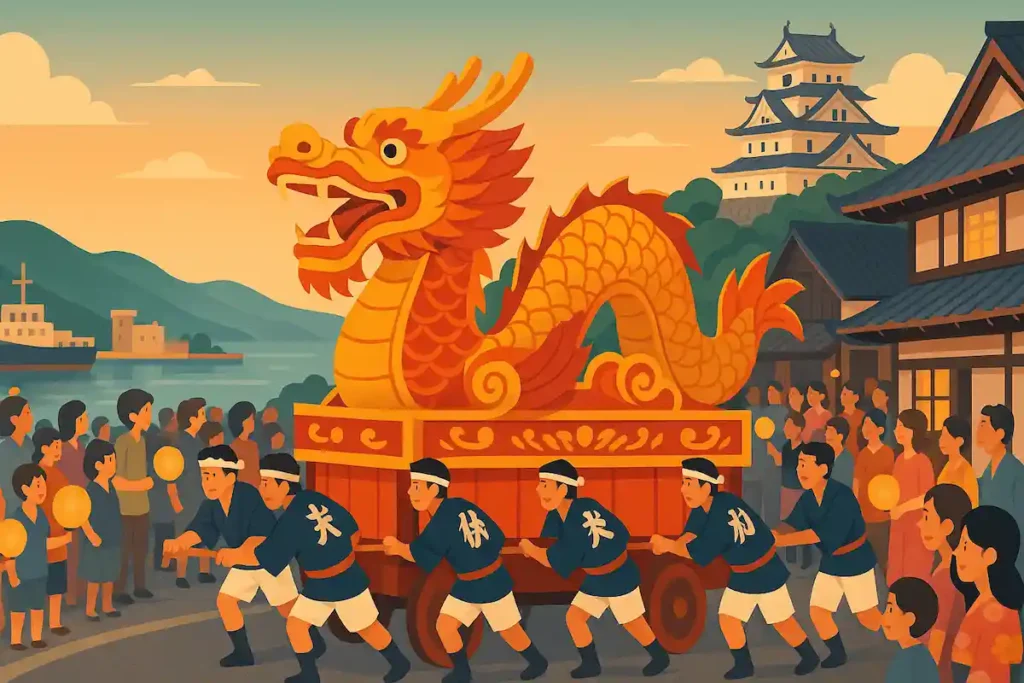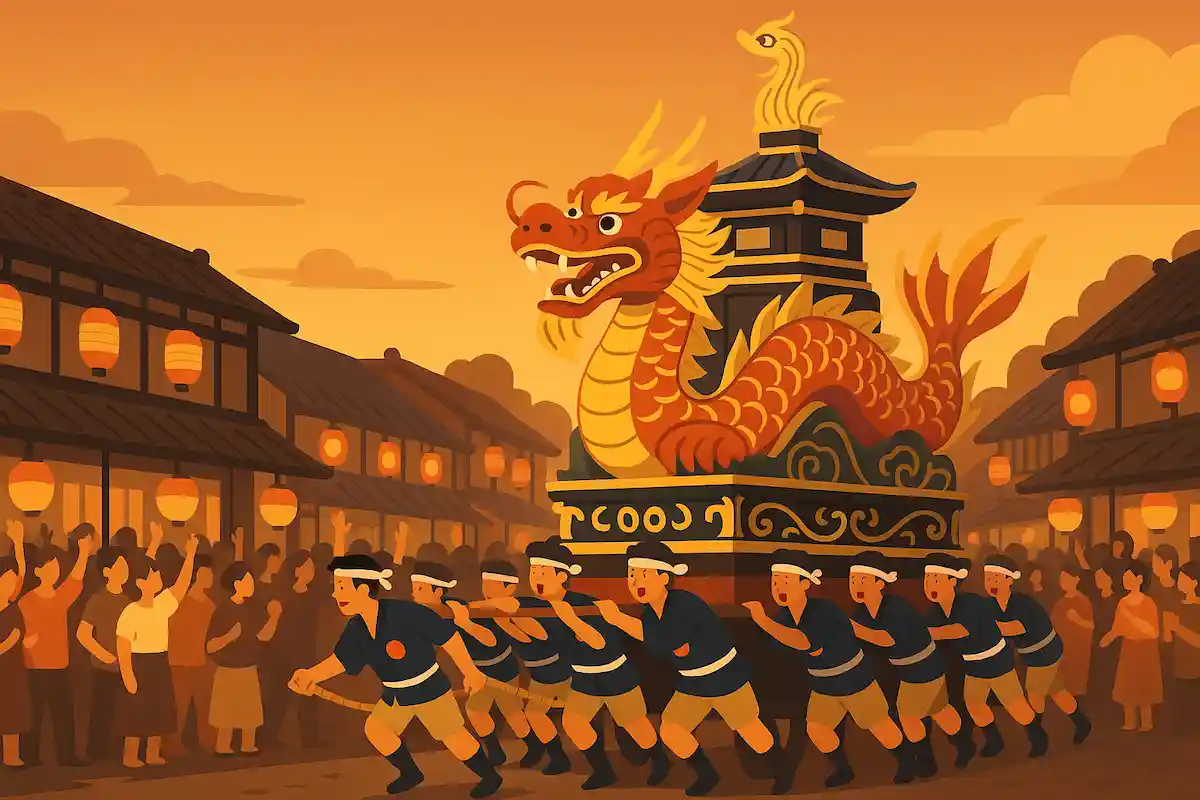唐津くんちを英語で説明・紹介するための基本情報と、英会話に役立つ表現をシンプルでわかりやすい英語で紹介します。
英会話ダイアローグ・概要・10の質問を通して、唐津くんちに関する英語表現を学びます。
英語
英会話ダイアローグを読む前に知っておくと良い前提知識と情報です。
- 唐津くんちの基本情報
- 佐賀県唐津市で開催される400年の歴史を持つ伝統的な秋祭り
- 毎年11月2-4日の3日間開催される
- 九州地方を代表する大きな祭りの一つで、約50万人の観光客が訪れる
- 曳山(ひきやま)について
- 祭りのメインとなる14台の装飾山車、木製で漆や金箔で美しく装飾されている
- 赤獅子、青獅子、鯛、亀と浦島太郎など、それぞれテーマが異なる
- 地域住民が「エンヤ」の掛け声で引いて練り歩く
- 主な行事
- 11月2日:宵曳山(よいやま)
- 提灯を灯した曳山が夜の市街地を巡行
- 幻想的で写真映えする光景
- 11月3日:御旅所神幸(おたびしょしんこう)
- 唐津神社の神輿を先頭に曳山14台が巡行
- 西の浜で迫力ある砂曳きが行われる
- 11月4日:翌日祭
- ゆったりとした巡行で旧城下町を回る
- 曳山が展示場に納められ、祭りが終了
- 11月2日:宵曳山(よいやま)
- 文化的価値と意義
- ユネスコの無形文化遺産(「山・鉾・屋台行事」)の一部
- 国の重要無形民俗文化財に指定
- 地域コミュニティの結束と誇りの象徴
2人が唐津くんちについて話しています。
400年の歴史、開催時期・3日間の日程、豪華な曳山、祭りの雰囲気などを話題にしています。
会話 / dialogue

Hey Key, have you ever heard of a festival called Karatsu Kunchi?

Yeah, I have! It’s a huge autumn festival in Karatsu City, Saga Prefecture. Why do you ask?

I saw some photos online of these massive, colorful floats. They looked amazing, so I wanted to know more.

Those are called “Hikiyama.” There are 14 of them, each with a different design, like dragons, helmets, or sea bream.

Wow, so they’re not all the same?

Not at all. They’re made of wood and paper, decorated with lacquer and gold leaf. They’re really impressive up close.

When is the festival held?

Every year from November 2 to 4. It’s been going on for about 400 years, since the Edo period.

Four hundred years? That’s incredible. What was the original purpose?

It started as a way to pray for good harvests and safety at sea. Karatsu was a busy port town, so both were very important.

I see. So what happens during the three days?

On the first night, there’s the Yoi-Yama—a night parade where the floats are lit with lanterns. It’s magical.

Sounds beautiful. What about the second day?

That’s the Otabisho Shinko, the main parade. The shrine’s mikoshi goes first, then all 14 floats follow, with exciting sand-pulling at Nishinohama beach.

And the third day?

It’s called the Yokujitsu-sai. It’s more relaxed, with the floats parading through the old castle town before they are returned to the exhibition hall.

I imagine it must get pretty crowded.

Definitely. Around 150,000 to 500,000 people visit each year, making it one of Kyushu’s biggest autumn festivals.

What’s it like to watch in person?

The energy is amazing. Locals pull the floats while shouting “Enya” or “Yoisa.” You can feel the teamwork and pride.

Sounds like there’s a real community spirit.

Yes, and the festival is designated as an Important Intangible Folk Cultural Property of Japan and is part of UNESCO’s Intangible Cultural Heritage.

So it’s both a cultural treasure and a lively celebration.

Exactly. And you can combine it with sightseeing—Karatsu Castle, the Niji-no-Matsubara pine forest, or fresh squid in Yobuko.

You’re making me want to book a trip for November already.

You should! Just be sure to book early—hotels fill up fast during Karatsu Kunchi.
概要 / Overview
「唐津くんち」について、理解を深めるための「英語での概要」です。
唐津くんち

What is Karatsu Kunchi?
Karatsu Kunchi is a famous autumn festival held every year in Karatsu City, Saga Prefecture, Japan. Its official name is the Autumn Festival of Karatsu Shrine. The festival takes place from November 2 to November 4. It began in the early 17th century, during the Edo period, and has continued for about 400 years. It was originally held to pray for good harvests and safety at sea, which were very important for this port town.
The Highlights – Hikiyama Floats
The most famous feature of Karatsu Kunchi is the parade of “Hikiyama” floats. There are 14 floats, each with a unique design such as dragons, helmets, sea bream, turtles, and phoenixes. They are made using the dry-lacquer technique, with wood and paper covered in lacquer and gold leaf. Each float is huge, about 6–7 meters tall and weighing 2–5 tons. Seeing them move through the streets is an unforgettable sight.
Festival Events
On November 2, the “Yoi-Yama” night parade takes place. The floats are lit with paper lanterns, creating a magical scene. On November 3, the “Otabisho Shinko” is held. The shrine’s mikoshi leads, followed by all 14 floats, with exciting sand-pulling at Nishinohama beach. On November 4, the “Yokujitsu-sai” takes place. This is a more relaxed parade through the old castle town before the floats are returned to the exhibition hall.
Why It’s Special
Karatsu Kunchi is one of the most important autumn festivals in Kyushu, attracting around 150,000 to 500,000 visitors each year. The atmosphere is full of energy, with locals pulling the floats while shouting “Enya” and “Yoisa.” The festival is designated as an Important Intangible Folk Cultural Property of Japan and is part of UNESCO’s Intangible Cultural Heritage. Visitors can enjoy the festival together with sightseeing at Karatsu Castle, Niji-no-Matsubara pine forest, and the Yobuko Morning Market.
10の質問 / 10 questions
「唐津くんち」について、理解を深めるための「英語での10の質問」です。
1: What is Karatsu Kunchi?
Karatsu Kunchi is a traditional autumn festival held in Karatsu City, Saga Prefecture, Japan. It takes place every year from November 2 to 4.
2: How old is Karatsu Kunchi?
The festival began in the early 17th century, during the Edo period, and has continued for about 400 years.
3: What was the original purpose of the festival?
It was originally held to pray for good harvests and safety at sea, which were important for this port town.
4: What are Hikiyama floats?
Hikiyama are large festival floats made of wood and paper, decorated with lacquer and gold leaf. There are 14 in total, each with a unique design.
5: How big are the Hikiyama floats?
Each float is about 6–7 meters tall and weighs 2–5 tons. They are very impressive to see in person.
6: What happens on November 2?
On November 2, the “Yoi-Yama” night parade is held. The floats are lit with paper lanterns, creating a magical atmosphere.
7: What happens on November 3?
On November 3, the “Otabisho Shinko” takes place. The shrine’s mikoshi leads, followed by all 14 floats, with sand-pulling at Nishinohama beach.
8: What happens on November 4?
On November 4, the “Yokujitsu-sai” is held. It is a relaxed parade through the old castle town before the floats are returned to the exhibition hall.
9: How many people visit Karatsu Kunchi?
Around 150,000 to 500,000 people visit the festival each year, making it one of the largest autumn festivals in Kyushu.
10: Is Karatsu Kunchi recognized as a cultural heritage?
Yes, it is designated as an Important Intangible Folk Cultural Property of Japan and is part of UNESCO’s Intangible Cultural Heritage.

和訳付
会話 / dialogue

Hey Key, have you ever heard of a festival called Karatsu Kunchi?
ねえキー、「唐津くんち」っていうお祭り、聞いたことある?

Yeah, I have! It’s a huge autumn festival in Karatsu City, Saga Prefecture. Why do you ask?
うん、あるよ!佐賀県唐津市で開かれる大きな秋祭りだよ。どうして?

I saw some photos online of these massive, colorful floats. They looked amazing, so I wanted to know more.
ネットで巨大でカラフルな山車の写真を見たんだ。すごくきれいで、もっと知りたくなったんだよ。

Those are called “Hikiyama.” There are 14 of them, each with a different design, like dragons, helmets, or sea bream.
あれは「曳山」って呼ばれてるんだ。全部で14台あって、龍とか兜とか鯛とか、それぞれ違うデザインなんだよ。

Wow, so they’re not all the same?
へぇ、全部同じじゃないんだ?

Not at all. They’re made of wood and paper, decorated with lacquer and gold leaf. They’re really impressive up close.
全然違うよ。木と和紙で作られて、その上に漆や金箔で仕上げてあるんだ。近くで見ると本当に迫力あるよ。

When is the festival held?
そのお祭りっていつやってるの?

Every year from November 2 to 4. It’s been going on for about 400 years, since the Edo period.
毎年11月2日から4日までだよ。江戸時代からおよそ400年も続いてるんだ。

Four hundred years? That’s incredible. What was the original purpose?
400年?すごいな。もともとの目的は何だったの?

It started as a way to pray for good harvests and safety at sea. Karatsu was a busy port town, so both were very important.
五穀豊穣と海の安全を祈るために始まったんだよ。唐津は港町でにぎわってたから、どっちも大事だったんだ。

I see. So what happens during the three days?
なるほどね。じゃあ、その3日間で何をするの?

On the first night, there’s the Yoi-Yama—a night parade where the floats are lit with lanterns. It’s magical.
初日の夜は「宵曳山」っていう行事で、山車に提灯が灯されて夜の街を巡るんだ。すごく幻想的だよ。

Sounds beautiful. What about the second day?
きれいそうだね。じゃあ2日目は?

That’s the Otabisho Shinko, the main parade. The shrine’s mikoshi goes first, then all 14 floats follow, with exciting sand-pulling at Nishinohama beach.
「御旅所神幸」っていうメインの巡行だよ。神社の神輿が先頭で、そのあとに14台の曳山が続き、西の浜で迫力ある砂曳きが行われるんだ。

And the third day?
じゃあ3日目は?

It’s called the Yokujitsu-sai. It’s more relaxed, with the floats parading through the old castle town before they are returned to the exhibition hall.
「翌日祭」って呼ばれていて、落ち着いた雰囲気で旧城下町を巡行してから、曳山を展示場に納めるんだ。

I imagine it must get pretty crowded.
かなり混みそうだね。

Definitely. Around 150,000 to 500,000 people visit each year, making it one of Kyushu’s biggest autumn festivals.
うん、間違いなく。毎年およそ15万人から50万人が訪れて、九州でも有数の秋祭りなんだ。

What’s it like to watch in person?
実際に見るとどんな感じ?

The energy is amazing. Locals pull the floats while shouting “Enya” or “Yoisa.” You can feel the teamwork and pride.
迫力がすごいよ。地元の人たちが「エンヤ」「ヨイサ」って掛け声をかけながら曳くんだ。チームワークと誇りが感じられるよ。

Sounds like there’s a real community spirit.
まさに地域の一体感って感じだね。

Yes, and the festival is designated as an Important Intangible Folk Cultural Property of Japan and is part of UNESCO’s Intangible Cultural Heritage.
そうだね。それにこの祭りは国の重要無形民俗文化財に指定されていて、ユネスコの無形文化遺産の一部にもなっているんだ。

So it’s both a cultural treasure and a lively celebration.
じゃあ文化的なお宝でもあり、にぎやかな祭りでもあるんだね。

Exactly. And you can combine it with sightseeing—Karatsu Castle, the Niji-no-Matsubara pine forest, or fresh squid in Yobuko.
その通り。それに観光も一緒に楽しめるよ。唐津城や虹の松原、呼子の新鮮なイカとかね。

You’re making me want to book a trip for November already.
もう11月に行きたくなってきたよ。

You should! Just be sure to book early—hotels fill up fast during Karatsu Kunchi.
行くべきだよ!でも早めに予約してね。唐津くんちの時期はホテルがすぐ埋まるから。
概要 / Overview
唐津くんち

What is Karatsu Kunchi?
Karatsu Kunchi is a famous autumn festival held every year in Karatsu City, Saga Prefecture, Japan. Its official name is the Autumn Festival of Karatsu Shrine. The festival takes place from November 2 to November 4. It began in the early 17th century, during the Edo period, and has continued for about 400 years. It was originally held to pray for good harvests and safety at sea, which were very important for this port town.
唐津くんちは、日本の佐賀県唐津市で毎年行われる有名な秋祭りです。正式名称は「唐津神社秋季例大祭」です。開催日は毎年11月2日から4日まで。17世紀初頭の江戸時代に始まり、およそ400年間続いています。もともとは、この港町にとって重要だった五穀豊穣と海上安全を祈るために行われていました。
The Highlights – Hikiyama Floats
The most famous feature of Karatsu Kunchi is the parade of “Hikiyama” floats. There are 14 floats, each with a unique design such as dragons, helmets, sea bream, turtles, and phoenixes. They are made using the dry-lacquer technique, with wood and paper covered in lacquer and gold leaf. Each float is huge, about 6–7 meters tall and weighing 2–5 tons. Seeing them move through the streets is an unforgettable sight.
唐津くんちの最大の見どころは、「曳山(ひきやま)」と呼ばれる山車の巡行です。全部で14台あり、龍、兜、鯛、亀、鳳凰など、それぞれ異なるデザインです。木と和紙に漆と金箔を施す乾漆技法で作られています。高さは約6〜7メートル、重さは2〜5トンもあり、街を進むその姿は忘れられない光景です。
Festival Events
On November 2, the “Yoi-Yama” night parade takes place. The floats are lit with paper lanterns, creating a magical scene. On November 3, the “Otabisho Shinko” is held. The shrine’s mikoshi leads, followed by all 14 floats, with exciting sand-pulling at Nishinohama beach. On November 4, the “Yokujitsu-sai” takes place. This is a more relaxed parade through the old castle town before the floats are returned to the exhibition hall.
11月2日には「宵曳山」と呼ばれる夜の巡行が行われます。山車に提灯が灯され、幻想的な雰囲気を作り出します。11月3日は「御旅所神幸」で、神社の神輿が先頭を務め、14台の曳山が続き、西の浜での迫力ある砂曳きが見られます。11月4日は「翌日祭」で、旧城下町をゆったり巡行した後、曳山は展示場に収められ、祭りが締めくくられます。
Why It’s Special
Karatsu Kunchi is one of the most important autumn festivals in Kyushu, attracting around 150,000 to 500,000 visitors each year. The atmosphere is full of energy, with locals pulling the floats while shouting “Enya” and “Yoisa.” The festival is designated as an Important Intangible Folk Cultural Property of Japan and is part of UNESCO’s Intangible Cultural Heritage. Visitors can enjoy the festival together with sightseeing at Karatsu Castle, Niji-no-Matsubara pine forest, and the Yobuko Morning Market.
唐津くんちは九州でも特に重要な秋祭りの一つで、毎年約15万人から50万人が訪れます。「エンヤ」「ヨイサ」という掛け声とともに地元の人々が曳山を引く様子は、活気に満ちています。この祭りは国の重要無形民俗文化財に指定されており、ユネスコの無形文化遺産の一部にも登録されています。祭りとあわせて、唐津城、虹の松原、呼子の朝市などの観光も楽しめます。
10の質問 / 10 questions
1: What is Karatsu Kunchi?
唐津くんちとは何ですか?
Karatsu Kunchi is a traditional autumn festival held in Karatsu City, Saga Prefecture, Japan. It takes place every year from November 2 to 4.
唐津くんちは、日本の佐賀県唐津市で行われる伝統的な秋祭りです。毎年11月2日から4日まで開催されます。
2: How old is Karatsu Kunchi?
唐津くんちはどのくらいの歴史がありますか?
The festival began in the early 17th century, during the Edo period, and has continued for about 400 years.
この祭りは17世紀初頭の江戸時代に始まり、およそ400年間続いています。
3: What was the original purpose of the festival?
この祭りのもともとの目的は何ですか?
It was originally held to pray for good harvests and safety at sea, which were important for this port town.
もともとは、この港町にとって重要だった五穀豊穣と海上安全を祈るために行われていました。
4: What are Hikiyama floats?
曳山とは何ですか?
Hikiyama are large festival floats made of wood and paper, decorated with lacquer and gold leaf. There are 14 in total, each with a unique design.
曳山は木と和紙で作られ、漆や金箔で装飾された大型の祭り用の山車です。全部で14台あり、それぞれ異なるデザインです。
5: How big are the Hikiyama floats?
曳山はどのくらいの大きさですか?
Each float is about 6–7 meters tall and weighs 2–5 tons. They are very impressive to see in person.
各曳山は高さ約6〜7メートル、重さ2〜5トンほどあります。実際に見るととても迫力があります。
6: What happens on November 2?
11月2日には何が行われますか?
On November 2, the “Yoi-Yama” night parade is held. The floats are lit with paper lanterns, creating a magical atmosphere.
11月2日には「宵曳山」という夜の巡行が行われます。山車に提灯が灯され、幻想的な雰囲気になります。
7: What happens on November 3?
11月3日には何が行われますか?
On November 3, the “Otabisho Shinko” takes place. The shrine’s mikoshi leads, followed by all 14 floats, with sand-pulling at Nishinohama beach.
11月3日には「御旅所神幸」が行われます。神社の神輿が先頭を務め、14台の曳山が続き、西の浜で砂曳きが行われます。
8: What happens on November 4?
11月4日には何が行われますか?
On November 4, the “Yokujitsu-sai” is held. It is a relaxed parade through the old castle town before the floats are returned to the exhibition hall.
11月4日には「翌日祭」が行われます。旧城下町をゆったり巡行し、その後曳山が展示場に納められます。
9: How many people visit Karatsu Kunchi?
唐津くんちには何人くらい訪れますか?
Around 150,000 to 500,000 people visit the festival each year, making it one of the largest autumn festivals in Kyushu.
毎年約15万人から50万人が訪れ、九州でも最大級の秋祭りの一つです。
10: Is Karatsu Kunchi recognized as a cultural heritage?
唐津くんちは文化遺産として認められていますか?
Yes, it is designated as an Important Intangible Folk Cultural Property of Japan and is part of UNESCO’s Intangible Cultural Heritage.
はい、国の重要無形民俗文化財に指定されており、ユネスコの無形文化遺産にも登録されています。

words & phrases
英会話ダイアローグと関連情報に出てきた単語・フレーズです(例文は各3つ)。

massive : 形容詞 /ˈmæs.ɪv/
意味: 非常に大きい、巨大な。Very large in size, amount, or degree.
(唐津くんちの曳山(ひきやま)の大きさや迫力を表すために使用)
例文:
- The festival featured massive floats decorated with gold.
「祭りでは金で飾られた巨大な山車が登場しました。」 - The earthquake caused massive damage to the city.
「地震は街に甚大な被害をもたらしました。」 - He made a massive improvement in his English skills.
「彼は英語力を大きく向上させました。」
port : 名詞 /pɔːrt/
意味: 港、港町。A town or city with a harbor where ships load and unload goods.
(唐津がかつて重要な港町だったことを示す。海上安全祈願の背景説明に使用)
例文:
- Karatsu was once a busy port for trade with other countries.
「唐津はかつて他国との交易でにぎわう港でした。」 - The ship arrived at the port early in the morning.
「その船は朝早く港に到着しました。」 - Many fishermen work in this port.
「多くの漁師がこの港で働いています。」
lively : 形容詞 /ˈlaɪv.li/
意味: 活気のある、元気いっぱいの。Full of life, energy, and activity.
(唐津くんちの賑やかで活気のある雰囲気を描写)
例文:
- The streets were lively with music and shouting during the parade.
「パレードの間、通りは音楽と掛け声で活気にあふれていました。」 - She has a lively personality.
「彼女は活発な性格をしています。」 - Markets in the city become lively in the evenings.
「その街の市場は夕方になると賑やかになります。」
combine : 動詞 /kəmˈbaɪn/
意味: 組み合わせる、結びつける。To join or bring together two or more things.
(唐津くんちの観光と、周辺観光地訪問を一緒に楽しむことを表す)
例文:
- You can combine the festival visit with a trip to Karatsu Castle.
「祭り訪問と唐津城への旅行を組み合わせることができます。」 - She combined several ideas to make a new plan.
「彼女はいくつかのアイデアを組み合わせて新しい計画を立てました。」 - Rice and miso soup combine well in a traditional Japanese breakfast.
「ご飯と味噌汁は日本の伝統的な朝食によく合います。」
fill up : 句動詞 /ˈfɪl ˌʌp/
意味: 満員になる、いっぱいにする。To become full or make something full.
(唐津くんち期間中にホテルが満室になることを表す)
例文:
- Hotels fill up quickly during Karatsu Kunchi.
「唐津くんちの間、ホテルはすぐに満室になります。」 - The bus filled up before it left the station.
「バスは駅を出発する前に満席になりました。」 - Please fill up the bottle with water.
「そのボトルに水をいっぱい入れてください。」
